Living Beyond Your Means As A Collector: How To Avoid Getting Hurt
by GaryG
When collectors gather anywhere and talk about their collections, recent purchases, and executed or potential sales, there’s an expression that comes up more often than not: “getting hurt.”
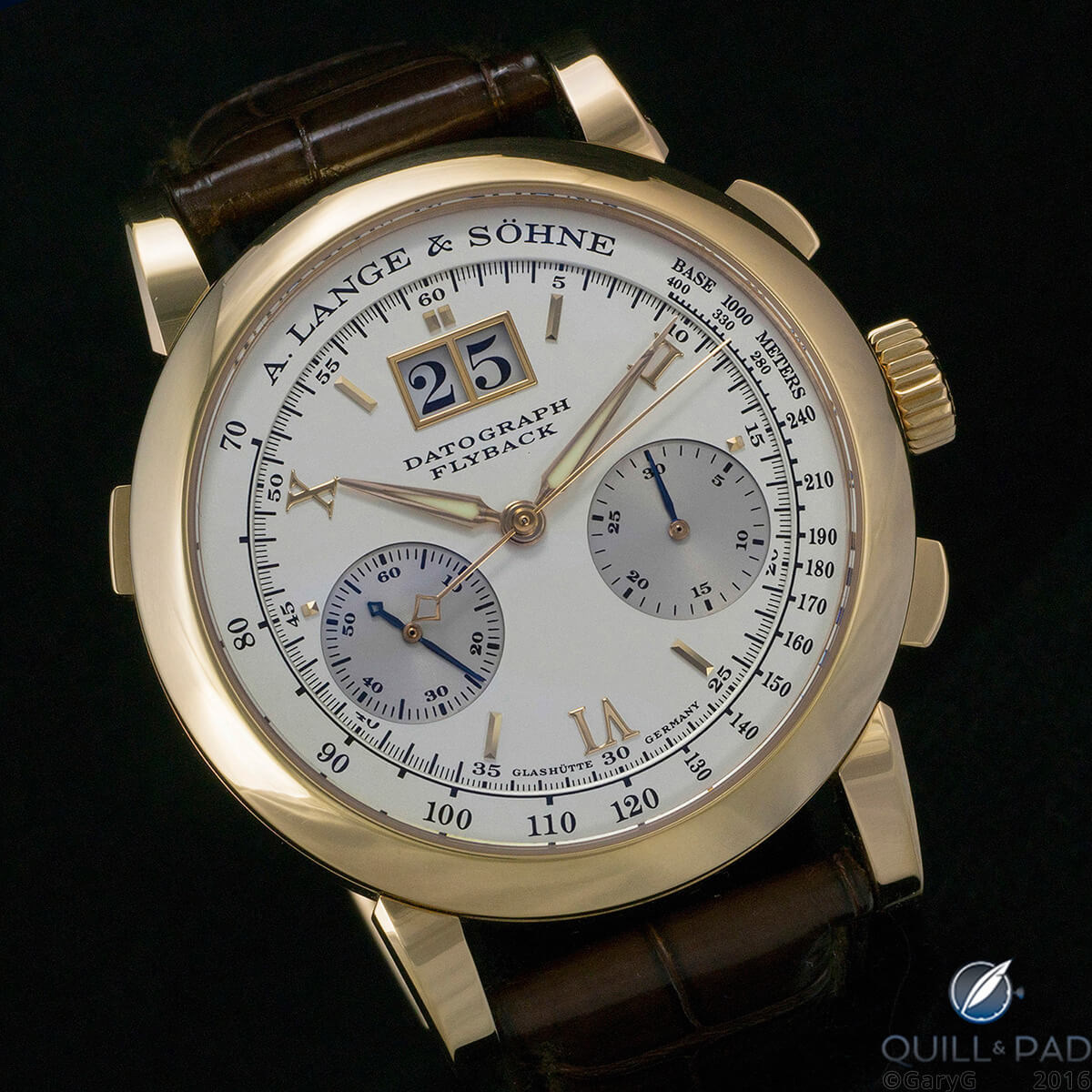
Unlikely to inflict pain: A. Lange & Söhne’s Datograph
That’s as in, “I heard that Gunther really got hurt when he sold that blinged-out limited edition watch,” or “If you get that watch at the upcoming auction anywhere in the estimated price range, you’re not going to get hurt.”
Or, most painfully, sitting alone at home realizing that a watch that you really had to stretch your resources to buy is worth much less than you would like.
And, yet, as collectors we are surrounded by glittering objects of desire, too many of which seem just out of the range of financial prudence to acquire.
What to do?
The first thing to know is that while I’m happy to share some lessons learned during my collecting career, the best way to avoid “getting hurt” on watches is not to buy any! I’m a watch guy not an investment advisor, so please treat my following observations accordingly.
Getting started without getting hurt
For the novice collector, there are really only a couple of rules.
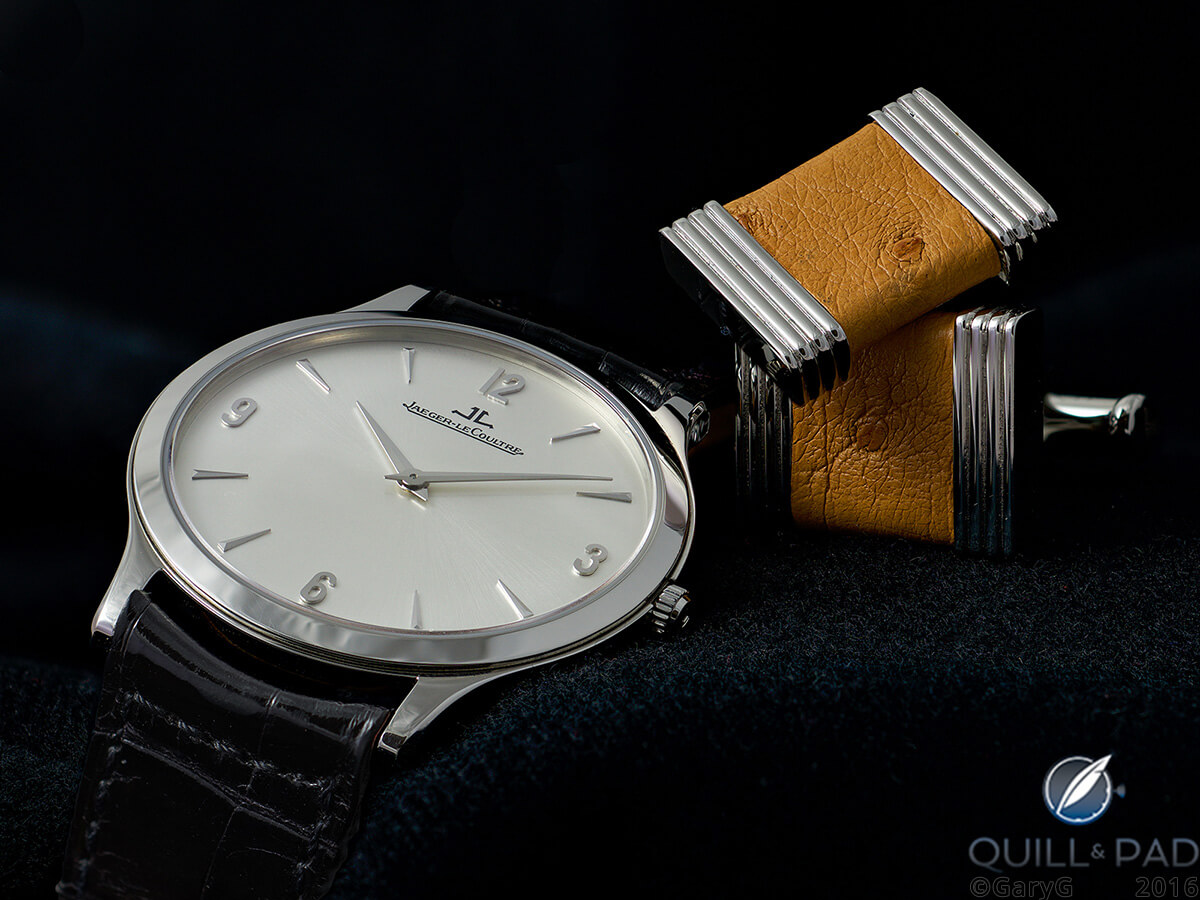
Getting started without getting hurt: the author’s Jaeger-LeCoultre Master Ultra Thin in stainless steel
Only spend what you can afford to lose: When you’re starting out, you’re going to buy some watches that you love but that won’t hold value. Don’t stress about it! Buy what you love and can afford; if you’re fortunate you’ll end up with some longterm keepers and if not you’ll have learned a lot about the world of watches, met some great people, and enjoyed an affordable hobby.
Expect to be illiquid: If and when you do decide to sell, either to move up or because your tastes have evolved, understand that the market for pre-owned pieces can move much more slowly than you might have thought. If you think you might need that “watch money” for near-term financial requirements then it’s not watch money. And if you do sell, be prepared to wait out the market and deal with some tire-kickers before you ultimately transact.

Not for beginners: the author’s Kari Voutilainen Masterpiece Chronograph II with bespoke dial and case
Moving on up: pain avoidance for the intermediate collector
Perhaps the most important advice on collecting I have received came from my friend Terry, who years ago shared his portfolio view of watch collecting. In the “Terry taxonomy,” there are three classes of watches: “fun” pieces that one can enjoy without considering economic consequences, “investment” pieces that have established market values and can serve as the core of a well-curated collection, and “patronage” pieces, usually by independent watchmakers, that promote watchmaking’s creative arts.
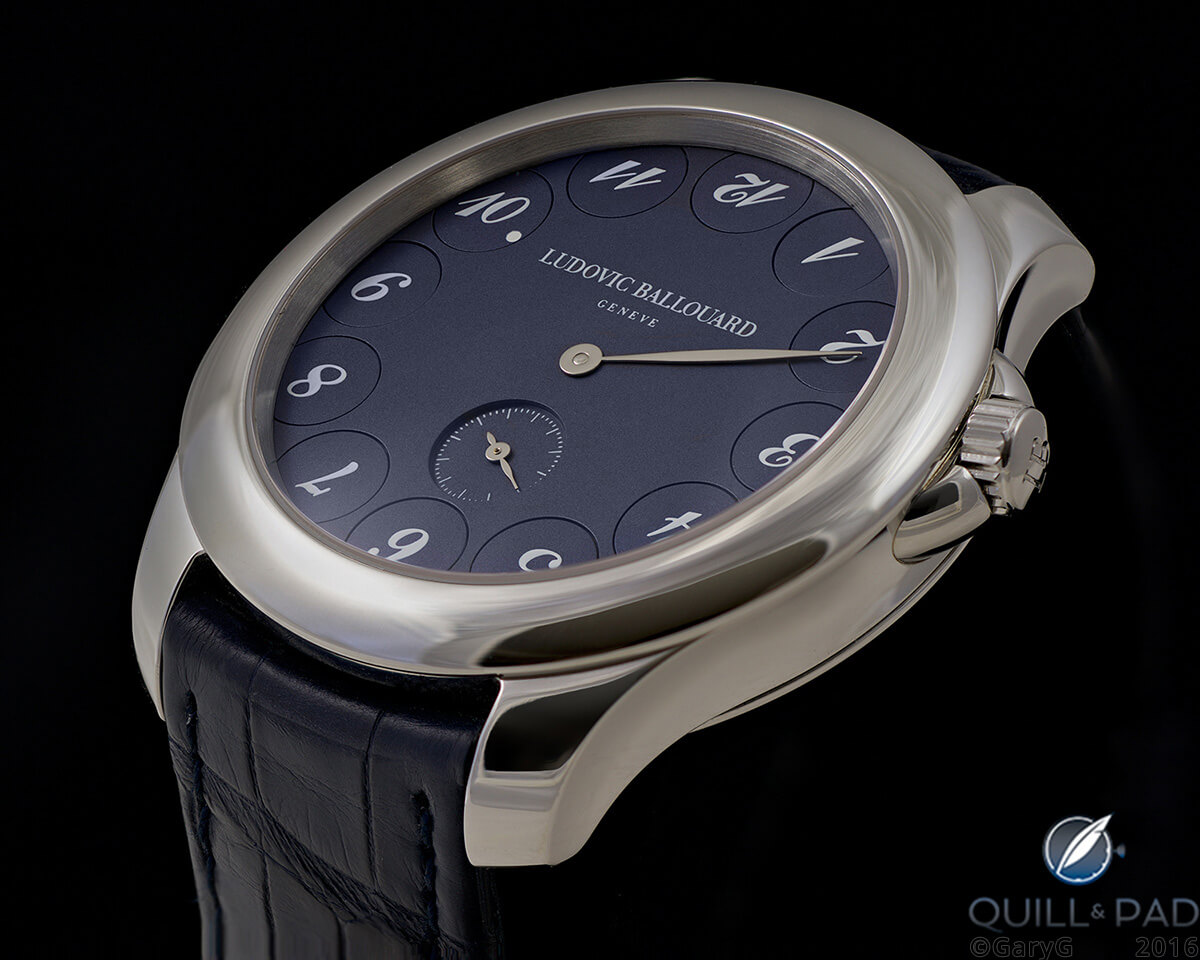
Patronage in action: the author’s Ludovic Ballouard Upside Down
Manage your portfolio: Decide how much “fun” money you have and how much you are willing to devote to patronage and keep the rest aside for mainstream, classic pieces (more about those below). From time to time as you sell and buy, do a quick check of your portfolio balance to make sure that you aren’t biased too heavily toward fun or patronage for your comfort.
Sell to buy: Trust me, it’s sad to sell! At certain points, however, it makes no sense to pour more money into a single, illiquid class of assets like watches. Setting a firm “sell to buy” rule can help. It also helps to build curation skills: if you don’t like that new piece better than any of your existing ones, is it really worth having?
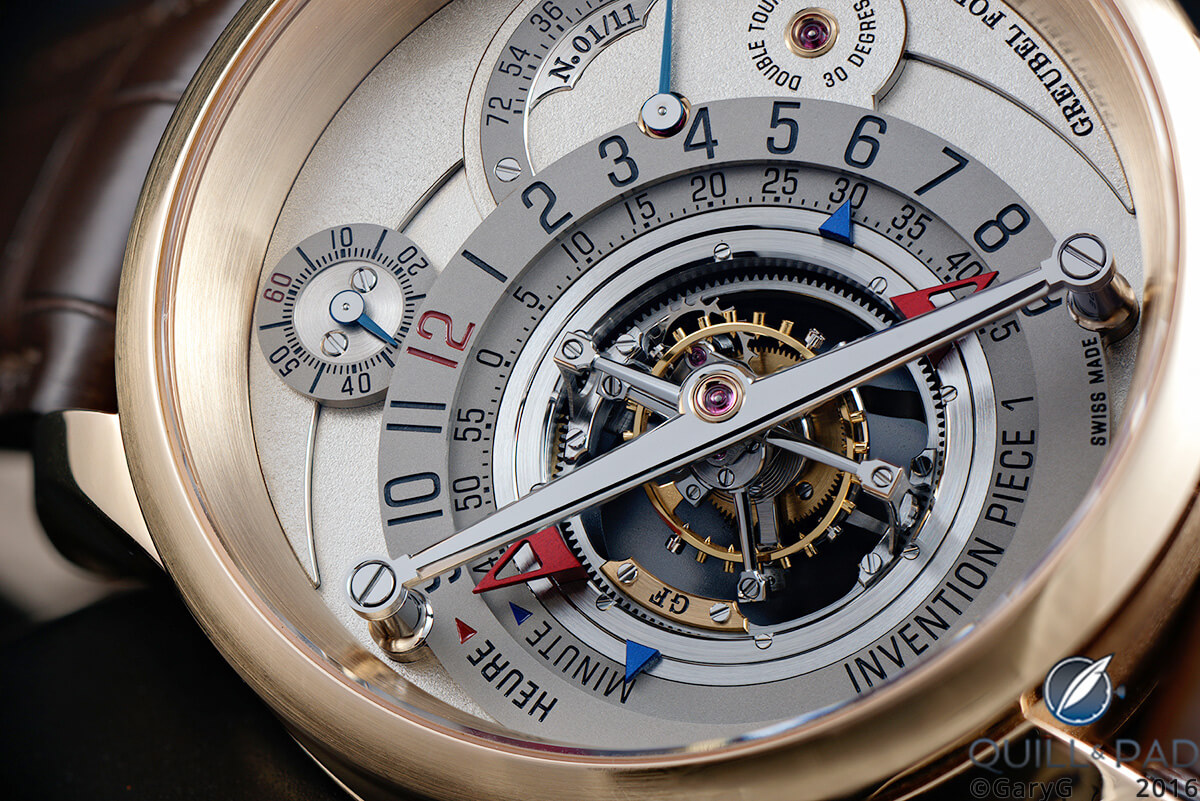
Had to sell to buy: the author’s Greubel Forsey Invention Piece 1
Understand breadth of appeal: Some of the greatest watches ever made have extremely thin markets. Years ago I bought a pre-owned Audemars Piguet Jules Audemars Equation of Time, a watch based on the legendary 2120 automatic movement with complications including a perpetual calendar, moon phase, equation of time display, and the times of sunrise and sunset in San Francisco.
It’s a good thing I love it: I paid a fraction of its original retail price, and it’s worth even less now! The same goes for skeletonized and engraved watches: I own both, but they aren’t everyone’s cup of tea.
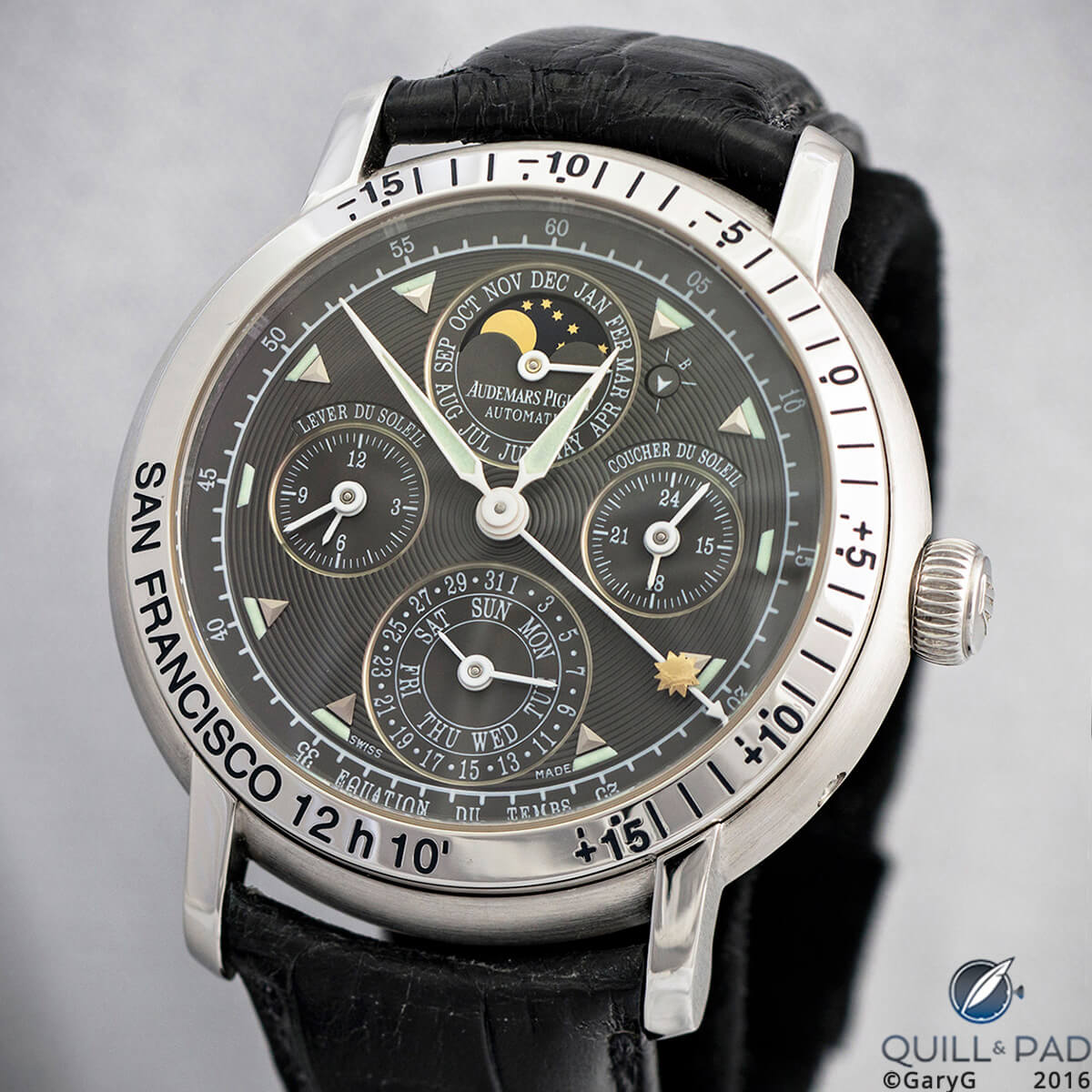
Fabulous watch, thin market: the author’s Audemars Piguet Jules Audemars Equation of Time
While you’re at it, take a look at the pre-owned values of various brands: while every purchase need not be from the “big three” manufacturers or even from major brands like Jaeger-LeCoultre or Omega, all brands are not equal when it comes to value retention.
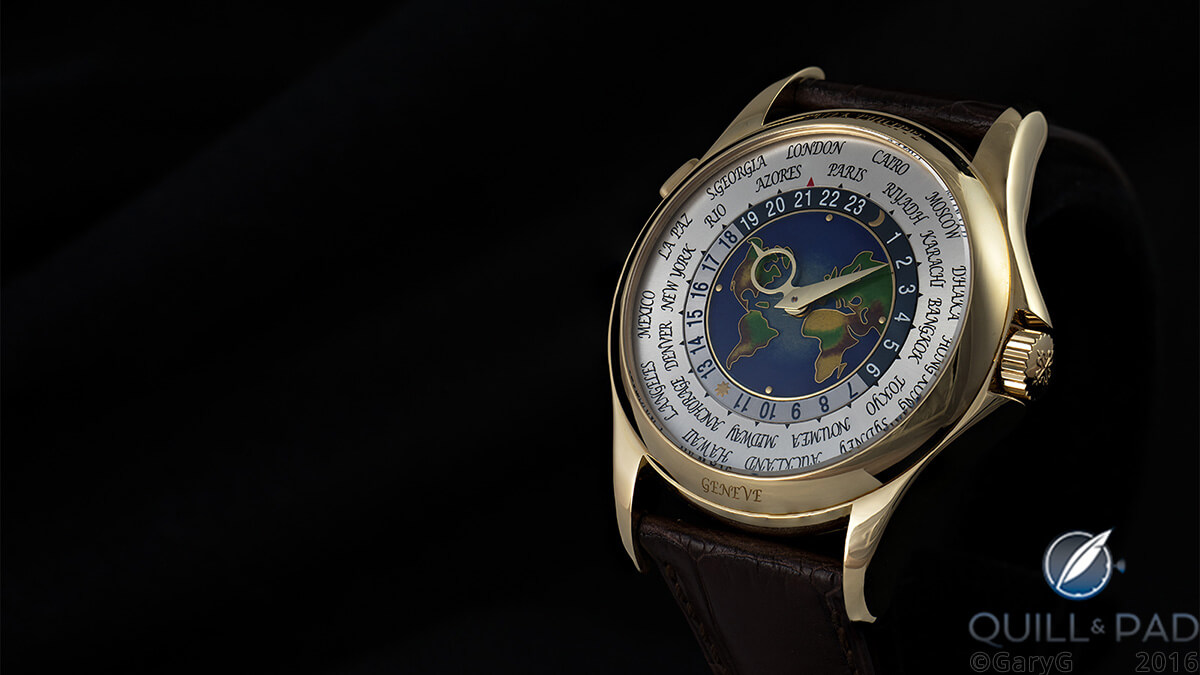
Take one at retail price and avoid pain: limited edition Patek Philippe 5131J
And shun the bling, at least at retail! At each major Hong Kong watch auction there’s a fantastic assortment of lovely jeweled watches selling for a fraction of their original prices; I’d hazard a guess that buying the watch you see on my wrist below would have exposed me to a world of hurt.
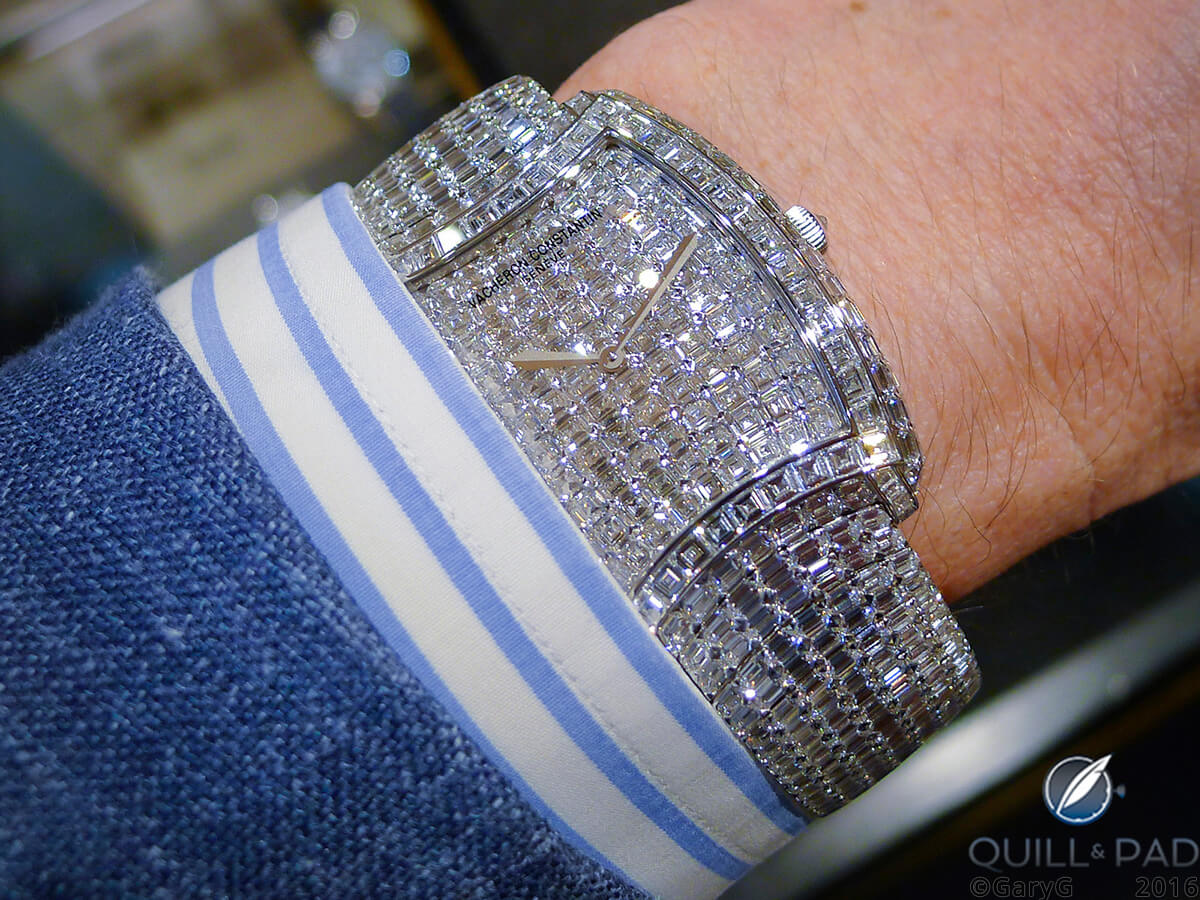
The bling’s not the thing: diamond-encrusted platinum Vacheron Constantin on the author’s wrist
Buy classics you love: Note that I didn’t just say, “Buy the classics!” It would be a boring world indeed if we all owned the same pieces, but one central criterion for the “investment” portion of one’s watch portfolio is that the pieces in it be desirable to many others and therefore somewhat liquid and predictable in value.
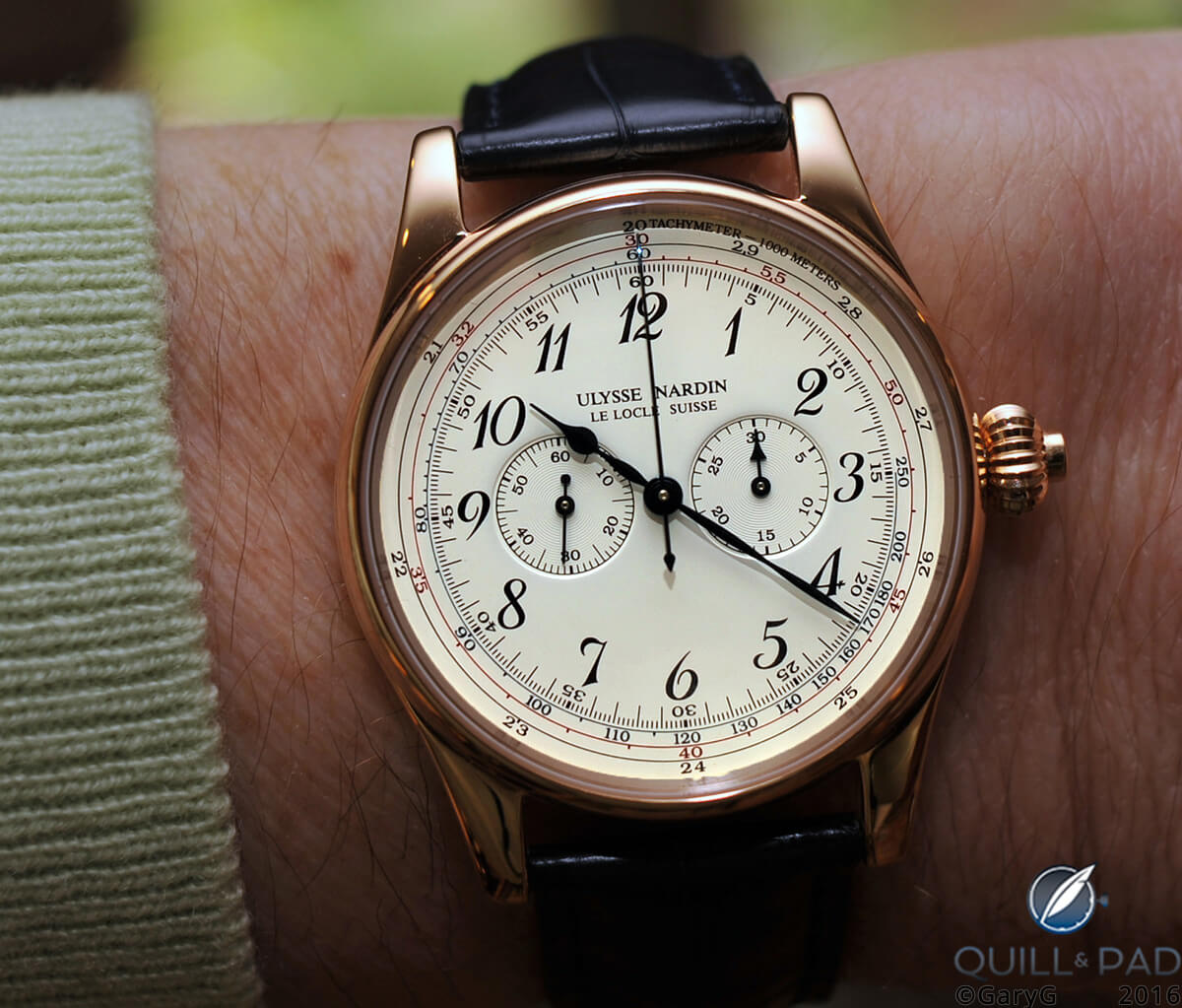
Affordable classic: Ulysse Nardin Monopusher Chronograph with F.P. Journe-designed movement on the author’s wrist
Within this category, find your passion at the same time you begin to consider longterm value. I owned an A. Lange & Söhne Datograph for several years before moving on to two “bigger” Lange chronographs: the Double Split and Datograph Perpetual.
When I finally bought a Rolex, it was the sought-after GMT-Master II “Batman” rather than a more obscure piece, and if I ever do buy an Audemars Piguet Royal Oak, it’s going to be that tasty 15202 “Jumbo” in stainless steel with the blue dial, not something like the Rodeo Drive Offshore or another cosmetic limited edition.
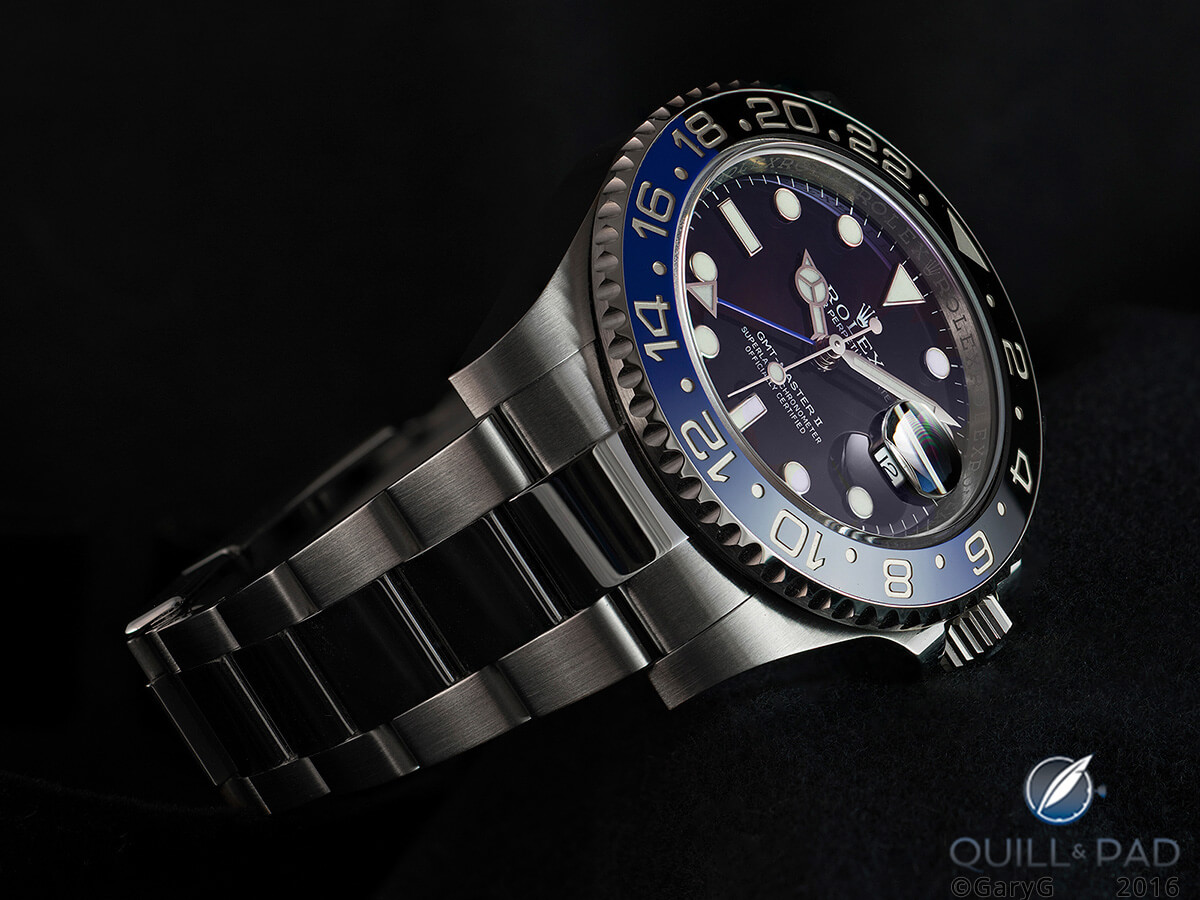
Mainstream value: the author’s Rolex GMT Master II BLNR “Batman”
Buy pre-owned: As my pal Larry says, “It’s going to be used when I sell it, so it might as well be used when I buy it.” As much as I love the feeling of owning a brand-new watch (and I do buy new pieces from both authorized retailers and independent watchmakers), my view is that I’m much less likely to get hurt if I’m buying watches with established resale price histories.
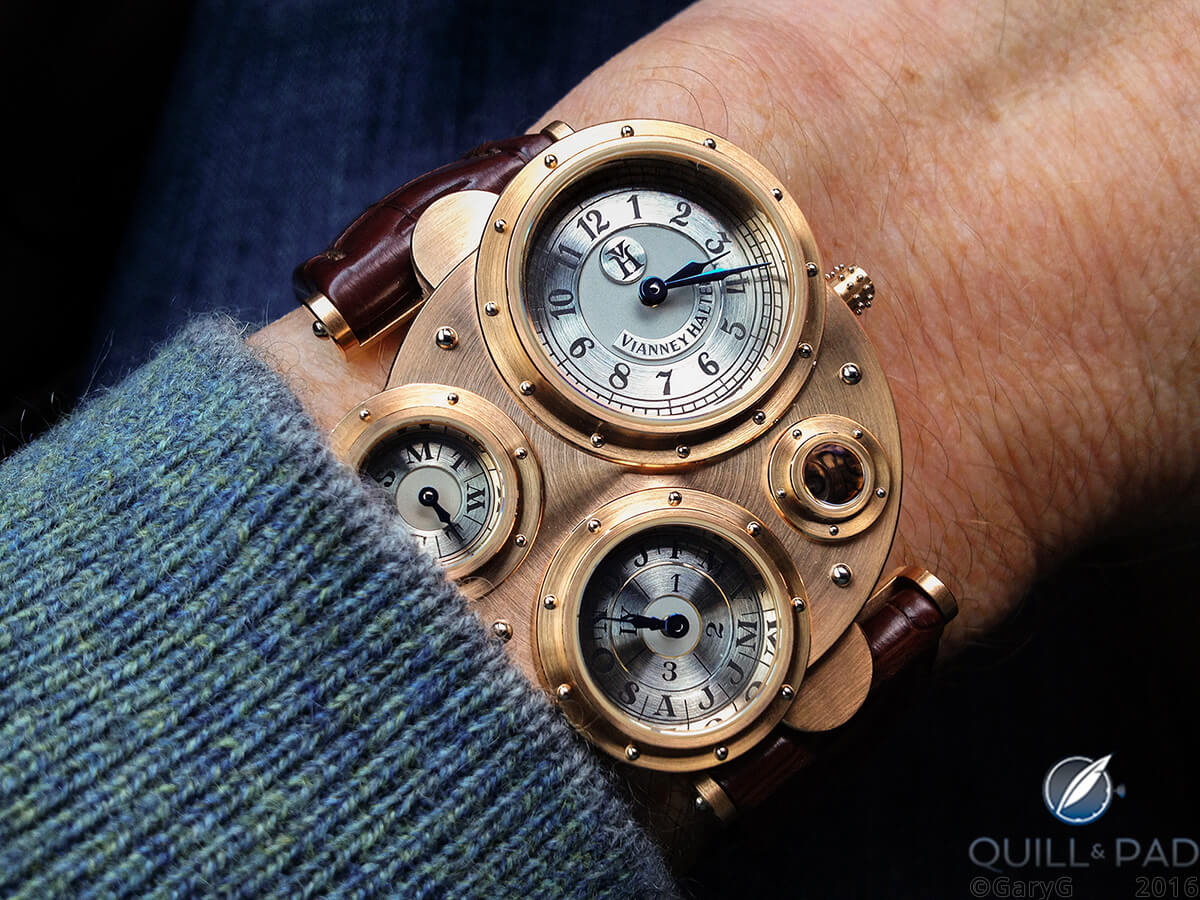
Bought pre-owned: the author’s Vianney Halter Antiqua
Bargain hard: Particularly in today’s environment, don’t be bashful! It stands to reason that the less you pay at the outset, the less likely you are to get hurt. And if you’re going to violate this rule by buying a boutique piece at full retail price, think hard about whether it’s truly an “investment” item or whether you should really be thinking about it as a more volatile “fun” expenditure.
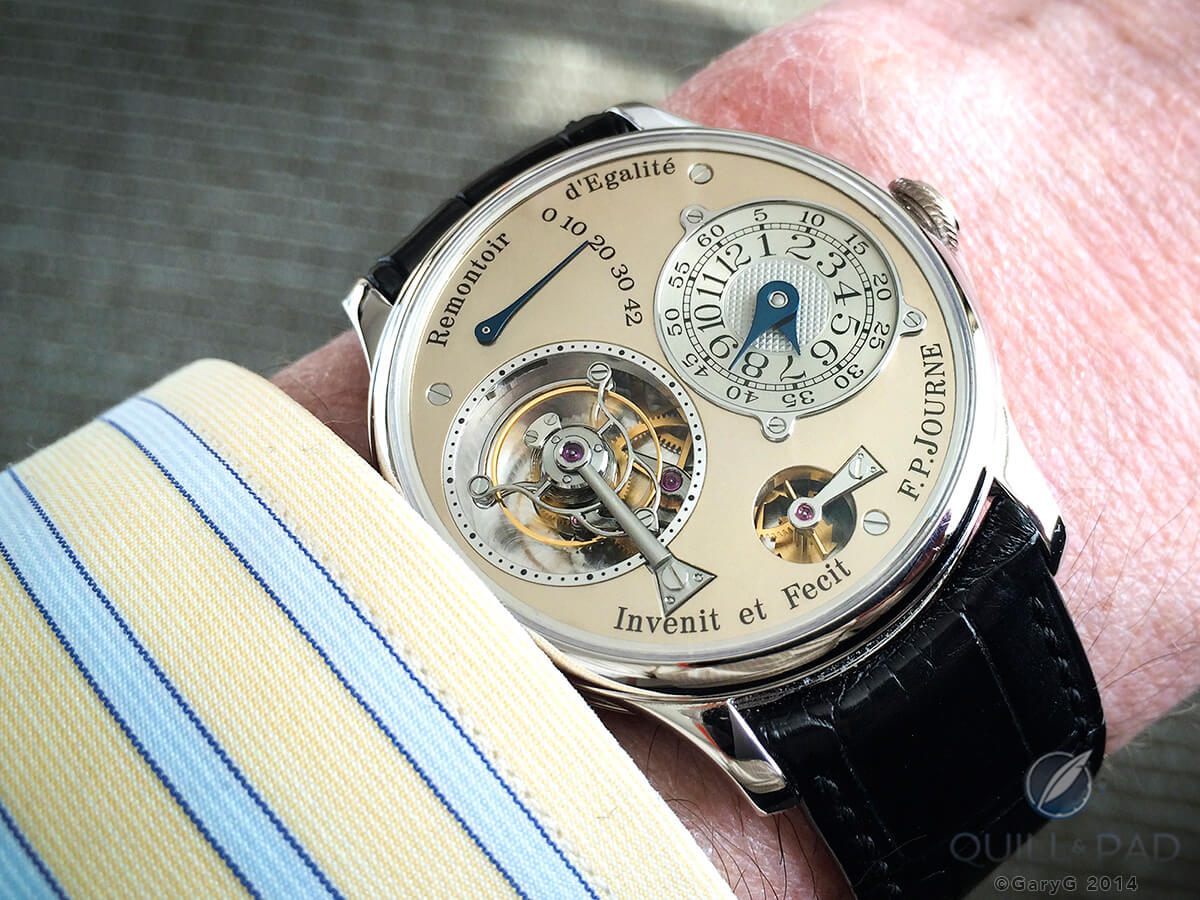
It’s good to have friends: the author’s early F.P. Journe Tourbillon Souverain, bought from a friend
Build your network: I have great friends who are private dealers and auction house members, but there are a lot of wonderful watches out there that still trade privately within networks of friends at zero sales commission. I can count a good dozen pieces that I’ve bought or sold that way, and among other things it’s a bit of innocent fun to bust the prior owner’s chops about a particularly great watch that you sweet-talked him into selling.
Master class: a few final tips
Wait out the cycles: It’s not a universal phenomenon, but I’ve observed that a great many desirable watches follow a predictable price trajectory over time. At launch, there’s a lot of excitement and a wave of initial purchases. After a period of months to a year, some early owners get antsy and want to sell, often at somewhat depressed prices: this provides a good buying opportunity.

Wait them out: the author’s A. Lange und Söhne Datograph Perpetual
Over time, certain watches become sought-after in the pre-owned market, and values march upward as demand exceeds supply. But then there’s a subsequent downward trend before a semblance of equilibrium sets in.
Good examples of this pattern are provided by the F.P. Journe Vagabondage I, which had a pre-owned value of more than $90,000 in its heyday but has now softened considerably, and the A. Lange & Söhne Datograph Perpetual, which for a while couldn’t be found pre-owned for less than $100,000.

One that got away: A. Lange & Söhne Pour le Mérite Tourbillon
It is possible to wait too long and miss the boat as prices continue to rise, as I did with the original A. Lange & Söhne Pour le Mérite Tourbillon, but remember: the goal here is avoiding pain, not speculating for profit.
Buy quality: I recently had the opportunity to buy a somewhat dinged-up example of a complicated Patek Philippe reference I’ve lusted after for some time at a mouth-watering price, but ultimately passed to continue my search for a mint-condition piece.
We’ve seen that at the high end of the vintage watch market, a great example often sells at multiples of what a less correct piece will draw; my sense is that this will also apply to watches in the expensive-but-not-stratospheric range in the years ahead. Opting for quality with these pieces, in my opinion, will reduce the risk of getting hurt despite the higher acquisition price.
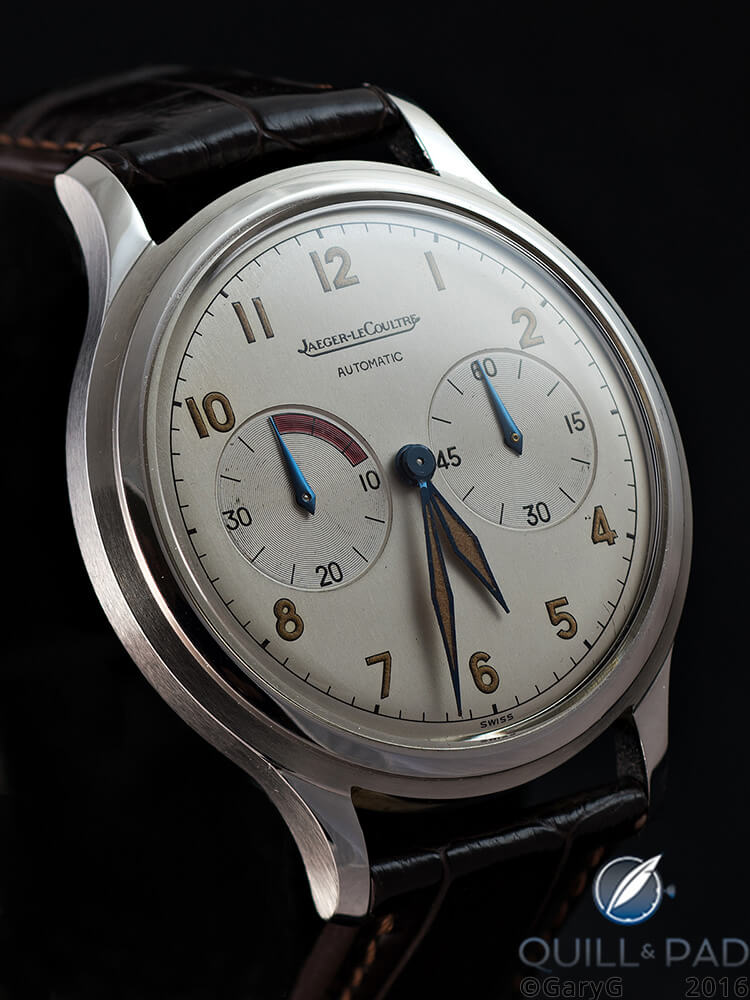
A few dollars more, but worth it: the author’s near-mint Jaeger-LeCoultre Futurematic
If you do buy at auction, by all means do your best to view the watches in person: one person’s “near mint” is another’s “chewed up,” and while miracles can be had through restoration, given the choice I’d opt for buying mint and wearing with care.
Finally, trust your tastes! If you’ve been collecting for decades and been through the wars, your sense of your own desires and the tastes of like-minded collectors should be pretty strong. Take advantage of that to buy emerging classics (for me watches like the Vianney Halter Antiqua and early F.P. Journe Tourbillon Souverain) or to extend your patronage portfolio a bit more toward deserving creators.

If you get hurt on this one call me: Philippe Dufour Simplicity
Getting hurt hurts! But with careful attention to your portfolio of watches you can enjoy more and worry less.
Trackbacks & Pingbacks
-
[…] This article was first published on October 8, 2016 at Living Beyond Your Means As A Collector: How To Avoid Getting Hurt. You may find some of the comments under that article […]
-
[…] *This article was first published on October 8, 2016 at Living Beyond Your Means As A Collector: How To Avoid Getting Hurt. […]
-
[…] The rules still apply (see Living Beyond Your Means As A Collector: How To Avoid Getting Hurt)! […]
Leave a Reply
Want to join the discussion?Feel free to contribute!



What a fantastic set of watches (sans the Vianney and diamond bling!). The Voutilainen just blows me away!!
Chacun a son gout – I love that Vianney Halter: maybe some day!
Thanks, John — sorry the Vianney is not to your taste, but I guess that’s why they make more than one kind of watch! The KV is one of my favorites — hope you had a chance to read my story here about its creation.
Best, Gary
A cracking set of principles Gary!
Completely agree with these, and Terry is bang in the money with his taxonomy…
Thanks, Ryan — I figured that others might appreciate the benefit of some of the lessons from my mistakes and the wisdom of my friends!
Best, Gary
It’s difficult to know where to buy pre owned watches, where to sell, how to judge authenticity, and estimate maintenance costs.
Hi Sano,
All excellent points — some of these questions have been covered in other posts here on Quill & Pad, and I plan to address others in upcoming articles. Thanks for your comment!
Great advice, whether you’re starting out or even an experienced “WIS.”
As you mentioned the market cycles and resets and tastes (prevailing internet “WISdom”) evolve I.e., Panerai, Speedmasters Moonies, and Royal Oak Offshores. Some fade away, some become iconic.
While many collectors may not reach the level of portfolio or patronage, we all need to remember to be grateful that we get to stress about something as trivial as the expenditure on a timepiece. There are many worse things that people face on a daily basis.
Gary, as usual the advice is valuable, however the photographs are priceless. Thank you.
Thanks very much for your kind remarks, Larry, and for passing on your own WISdom to me over the years!
Completely agree that it is important to remain grateful that we can participate in this hobby as collectors.
As for the ability of collectors to get to the “portfolio” level, how about a portfolio that has a pre-owned Habring or Speake-Marin as a patronage piece, a Nomos for fun, and an Omega Speedmaster as the “investment” watch? Still real money, but not out of reach for many, I’d suggest.
Hope to see you soon!
besides avoiding getting hurt… another tough part is what to let go when there are so much to go after out there…
Oh yes — I know exactly what you mean! At some point I’ll come back to the topic of “selling to buy” in more detail — thanks for taking the time to comment.
Best, Gary
Thanks for a very helpful and entertaining article, Gary!
I’m looking to learn more about selling vintage watches, since my brother passed away, leaving a rather large collection of mostly Accutrons. My mom wants to sell them for as close to retail as possible, and I’m trying to help her with that.
My pleasure, Judy — thanks for your comments!
My condolences on the loss of your brother — I know from personal experience the difficulties (both practical and emotional) of managing a loved one’s estate.
Accutrons are great pieces — I own a Spaceview myself — and should be relatively liquid compared to some other brands. I can’t really offer detailed advice (due to lack of knowledge!) but I do know that there are dealers out there who specialize in refurbishment and re-sale of Accutrons. Best wishes to you and your mom.
Hi Gary, what a fantastic write-up! I’ve been enjoying your IG account and very excited to come across your articles on Quill & Pad that I have yet to fully immerse myself into. I find your article offering sage advice that runs the full gamut from novice to experienced collectors. I feel it carries a different “weight” because of your eclectic collection with a mix, as you say, of fun – investment – and patronage watches. I know a handful of experienced collectors but the vast majority tend to be partial to a particular brand. Objectively, I’m also guilty with my fondness toward AL&S. So I feel you bring a fresh and more balanced perspective to watch collecting in general.
With that said, I couldn’t agree more on buying pre-owned. The only thing I’d add, which hits upon your “network building” and “buy quality”, is the importance of knowing your seller. I’ve learned who you buy from should be a key factor in the purchase process. It may come with a premium but what’s the price of “peace of mind”? From my personal experience, I took a misstep on a Lange where the price seemed too good to be true and I blindly bought it. I then noticed it was losing time out of the norm so I brought it to Alkis for a fresh service. Long story short, he gave me a laundry list of all the things that were wrong with it and that it was poorly serviced by a 3rd party. In fact, he used the word “butchered” to describe it. After multiple back & forths, the owner of the shop finally agreed to take it back and refund me in full. Not exactly a pleasant experience but one that I learned from nonetheless. Another quick example was when I unknowingly purchased a stolen watch from a reputable company that sells mostly pre-owned luxury watches. I had a great rapport with them over the years and bought my first watch “naked” based on a quirky reason. This story ended with me handing over the watch to my local police department after I received a heart stopping phone call at work, meeting the rightful owner who had his watch stolen in Rome while on vacation, and getting reimbursed from the company that sold me the watch. I can only imagine what the outcome might have been if it was from a stranger!
Another piece that rings rather loudly is “wait out the cycles”. I have learned over the years and even recently that I just need to … have … more … patience. My emotions have clouded my judgement on a few purchases that resulted in financial loss. I need to weave in the “sell to buy” strategy because I have tended, at times, to throw out logic only to act on emotion and prematurely purchase a watch thinking the “deal of the year” is going to slip away…only to lock up more $$$ in my watch collection which, as you accurately stated, is illiquid unlike the stock market. Most notably, I became blinded on my first limited edition piece because I had to have it … it was on my mind 24/7 but they were all spoken for. After scouring the world, I finally came across one that commanded a substantial premium from a reputable seller which I hastily paid (and actually would have paid more). Fast forward a couple years, and today this watch sits in my safe – hardly worn – with others popping up for asking prices that are ~30% less than my purchase price. Yes, that stings!
Sorry for the long reply but your article and advice hits me from multiple angles that resonate with me in which I decided to elaborate on a couple of the sharper ones. I’m sure there are collectors of all sorts that will benefit from your experiences. Thanks for taking the time to share this and very much looking forward to more!
Regards,
-Keven
Keven —
Thanks so much for these fantastic observations! Your note could be its own article — I really enjoyed reading your thoughts and, believe me, I feel your pain…
Glad you found me here and I hope you’ll enjoy some of my other scribblings!
Best, Gary
Gary,
As always, your words are sensible and well-reasoned.
And, of course, your watch collection and acquisition principles are impeccable.
Regard
Thanks very much, Roman — I appreciate your taking time to comment!
Best, Gary
This is a great article and made me cringe at a few things I have been guilty of over the last 20 years that I have been a WIS , with varying degrees of enthusiasm , I particularly remember an excellent article written over a decade ago called ‘ Descent into Nightmare ‘ by a guy called Ludwig .
His conclusion was to , at the outset , buy the very best piece you could afford and really liked and never , ever , read anything horology related for the rest of one’s life , sounded good in theory .
Another pitfall is to constantly associate with other like minded watch enthusiasts as , from my experience , we all tend to build up each others enthusiasm .
Ah yes — the dreaded encouragement of one’s friends! While our gang does from time to time encourage caution, I agree with you that the tone is much more often “that’s a killer piece!” than “I’m not sure about that one!” when discussing potential purchases by others.
Many thanks for commenting — and if you are associated with the other famous Tarts, please send along my warm greetings!
Best, Gary
First of all, I literally disregarded the text, sorry, Gary, don’t mean it in a bad way…your photo skills are now just incredible. Not just because they are extremely beautiful, but they inspire passion and love that only a true collector can infuse (and that’s where many skilled photographers fail).
On a another note, great read….full of wisdom, but, again, the most fun in collecting was when all the wisdom went out of the window and we fell in love with the watch in front of us.
After a few years we all develop a taste, an innate curating skill that suit our vision of a collection, hardly do we get really “hurt”.
I have myself watches that gained considerably and others that I won’t be able to sell, but will NEVER sell as too dear and beautiful to me, but never in my mind have I considered the resale or investment factor on a purchase. I am convinced that OVERALL, if you know and are passionate about watches, your collection will even itself out between pieces that held their value and others that maybe lost it as you tend to collect only reference pieces, either from big brands or independents.
Great article, I hope to see you soon.
Mo
Mo,
Thank you so much for the thoughtful remarks — you are certainly one of the few people I know who has developed the innate sense that allows for effective curation guided by passion! By the way, that word “passion” is so over-used in our hobby but for me clearly applies to you and some of our other friends who are deeply committed.
I’m so pleased that you think that my photos show that sort of emotion — I actually hear that observation with some frequency so it must be true, although I don’t know at all how it happens! Since it seems to work I won’t over-think the phenomenon too much.
Hope that all is well with you — and that I will see you in January if not sooner.
All the best,
Gary